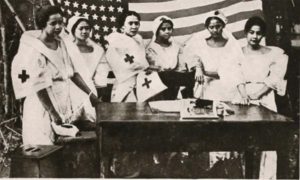
As I was taking a walk and admiring the Photoville exhibition in Brooklyn Bridge Park, I noticed a photo exhibit that caught my attention. The photos were touching and it was great to see real people behind the statistics. Unbeknownst to me Filipino people make up 4% of registed nurses in the U.S, (according to National Nurses United, the country’s largest nursing union) 26.4% of the medical staff dying from covid are Filipino medical staff. They account for 83 nurses out of 314 deaths where race and ethnic data was available. In the New York, New Jersey area, Filipino’s are hit hard since one in four works in healthcare. These statistics bring to the fore a community of people whose story is largely unknown and untold to the public at large.
The photos were taken by a nurse/photo journalist living in Baltimore, Maryland named Rosem Morton (pictured above). They are doctors, surgeons, nurses, medical assistants, medical directors, physical therapists, anesthesiologists, emergency medical technicians all involved in the healthcare industry and fighting the pandemic here in the U.S. head on.

History of Filipino nurses and medical staff coming to the U.S. an organic result or created by design?
Plagued by racially, politically incorrect, ignorant questions of,” Why are you here taking our jobs? You have such great English, why? Why are there so many Filipino nurses?” Rosem decided to do a bit of research into why so many Filipino people have decided to enter the medical industry and emigrate to the U.S. This is what she discovered:
Immigrants from the Phillipines make up over 13% of all foreign born health care workers, more than any other country according to 2018 numbers from the Migration Policy Institute. Also there are many U.S. born Filipinos who have followed family members into the medical industry. Is it an inherent part of Filipino culture organically or by specific design?
What Rosem found out is that Filipino’s presence in the medical industry is a lasting legacy of the U.S. colonization of the Philipines in first half of the 20th century, a fact many people aren’t aware of. In the book, Empire Of Care, Nursing and Migration in Filipino American History (by Catherine Ceniza Choy) during the U.S. occupation they imposed it’s culture, values and language on the Filipino colony. It also created an Americanized nursing program that primed Filipinos to fill the nursing shortages in the U.S. after World War 2. This inherently created a supply of nurses/medical staff that would later be easily funneled over to the U.S. Also add to that a mix of U.S./Filipino policies and the shortage of medical staff in American hospitals, there began to arise Filipino recruitment agencies and professional associations that would create a contingent of trained medical staff highly encouraged to emigrate and fill the shortage of medical staff here in the U.S.
They’ve been programmed to want to come to America to have better lives. Not the real reason, that the U.S. really needs them here to fill the void in hospitals for nurses and medical staff.

Profile of a Filipino nurse: Jennifer Bualaong was recruited by an agency to come to the U.S. from the Philipines.
Jennifer arrives in the U.S. in 2019 through a recruitment agency and needs to work 5,200 hours as a nurse at a Missouri hospital before she can transfer to a hospital near her family in Maryland. It is a contract that takes her three years to complete. They’ve been waiting for her to join them since 2016.
In the first photo she is visiting with her family for a few days before she has to go back to work in Missouri. They are making Filipino food for her to take back home to enjoy. The second photo shows Jennifer hugging her family before she jumps on the bus to return to Missouri to complete the rest of her contracted hours.
While working, Jennifer and the rest of the medical staff are in direct contact with people suffering from covid. She puts her head down and works through the hours, days and years through the stress of the pandemic until she can finally join her family.
Many other Filipino nurses have gone through the same thing, whittling away their hours to be able to join their families. When they were hit with the pandemic, they became front line workers.
The Bualaong family, three generations of nurses.
Jennifer’s grandmother was a nurse. Her mother is currently a nurse and her sister is studying online to become a nurse.
What they do to relax from a stressful day on the frontlines.
Filipino’s in the medical industry are just people like you and I living out their lives. Although they represent 32% of the the medical industry and aren’t reflected in popular medical television shows like E.R. and Grey’s Anatomy, they are an important part of the healthcare system in the U.S. helping to fight against the coronavirus and taking huge hits. They are surrounded by hospitals overrun with covid patients with staff and supply shortages.
There were photos of specific Filipino medical staff on their days off doing what they liked to do to relax from tough, 12 hour days and double shifts. In the photos above some liked to:
-garden at home in their apartment
-play guitar and sing with their partner and pet
-workout
-paint
-hangout with their child and partner
Final thoughts and what’s happened to Jennifer and Rosem so far.
Filipino’s continue to emigrate to the U.S. as the pandemic drags on and the psychological toll has caused nurses to quit in droves. When asked, Filipino nurses still think about the Philipines, friends and family that they have left behind.
Having worked on the frontlines for the past 18 months people in the healthcare industry are reacessing their career choices. Jennifer has since completed her requirement of 5,200 hours of service at the Missouri hospital that she was contracted to work and now lives with her family in Maryland. Rosem is taking a leave of absence from nursing and is now focusing more on her photography. Before she left, Jennifer said this year alone she has seen the Missouri hospital bring in more nurses from the Philipines every month.
Instead of treating Filipino medical staff with such insulting comments such as,”Why are you taking all our jobs?” we should be thanking them for coming here to help us. Meanwhile, in the Philipines the pandemic also rages on and people continue to die in hospitals with a larger shortgage of medical staff and supplies than we have here.



